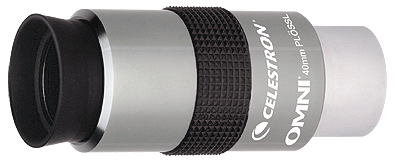Celestron Omni Plossl Eyepieces By the Astronomy and Photography Online Staff  It was the Celestron satin silver Plossl oculars of the 1980's that, probably more than any others, established the Plossl as the eyepiece of choice among amateur astronomers. Today there are more complex and expensive ocular designs on the market, but it is a Plossl that is usually supplied with telescopes from Meade, Celestron, Orion, Tele Vue and others. Indeed, two element achromatic oculars, three element Kellners or Modified Achromats and even four element Orthos are now seldom seen as OEM eyepieces supplied with upscale telescopes. Celestron's first generation of satin silver Plossl oculars was made in Japan (by Vixen) and are still highly regarded. The second generation was made in Taiwan and came with glossy black bodies. The latest generation of Plossl oculars, the Omni series that are the subject of this article, have striking bluish-silver bodies with checkered, black rubber grip bands (15mm focal length and longer) and are also made in Taiwan. The Plossl design uses four lens elements in two symmetrical groups. (Positive + negative elements in the first group and negative + positive elements in the second.) When executed properly, this apochromatic design provides a flat field, excellent sharpness and contrast from center to edge, a reasonable apparent field of view (AFOV) of around 50 degrees and adequate eye relief in medium and long focal lengths (from about 15mm and up). The eye relief becomes limited in short focal length Plossls. Plossl oculars work well in all types of telescopes and are excellent for general purpose astronomical, as well as terrestrial, viewing. In appropriate focal lengths, they can provide sharp, high magnification lunar and planetary views, split close double stars, resolve detail in dim planetary nebula and reveal distant globular clusters and galaxies. Celestron's Omni Plossls feature fully multi-coated lens elements, edge-blackened lenses and a two-step anodizing process to prevent reflection from the top eyepiece barrel, unlike most other manufactures whose eyepieces use reflective surfaces. Celestron Omni eyepieces come with 1.25" mounting barrels in the following focal lengths: 4mm, 6mm, 9mm, 12.5mm, 15mm, 32mm and 40mm. The angular field of the 40mm Omni Plossl is 43-degrees, all of the others have a 52-degree angular field.  Celestron's 2009 MSRP for Omni oculars is $61.99 for focal lengths from 4mm to 15mm and $80.99 for the 32mm and 40mm. Online discount prices are considerably lower. Optics Planet (www.opticsplanet.com), for example, sells the 4mm through 15mm Omni's for only $29.75 and the big 32mm and 40mm Omni's for $47.99. Obviously, there is not much that you could not look at with such a wide range of focal lengths. However, we find that the tiny exit pupils and 5mm-6mm eye relief of the 4mm, 6mm and 9mm Omni's make for less than comfortable viewing. The 12.5mm Omni is better in both regards with an 8mm eye relief and the 15mm has a reasonable 13mm eye relief, as long as you don't wear eyeglasses while observing. The 32mm and 40mm Omni's have eye reliefs of 22mm and 31mm respectively, large exit pupils and are nice to use. We prefer wide field, long eye relief oculars (despite their greater cost) to Plossls in the short focal lengths, but for the longer focal length oculars used for viewing most deep sky objects, it is still hard to beat a good Plossl. We have owned quite a few telescopes over the last 20 years and a great number of Celestron Plossl eyepieces. If we were building a new set of Celestron oculars today for a telescope in the common f/9 to f/13 focal ratio range, we would probably spring for premium X-Cel or Ultima oculars in the focal lengths shorter than 25mm. For 32mm and 40mm focal length oculars, we are quite satisfied with Omni Plossls. If we were operating on a tight budget, we could live with Omni's from 12.5mm on up. Please note that the same basic thinking would apply regardless of the brand of oculars in question. Celestron Omni Plossls are fine examples of the type and there are no Plossls with which we have had more experience. |